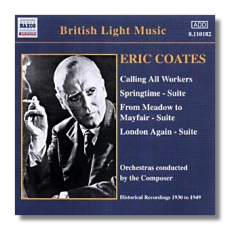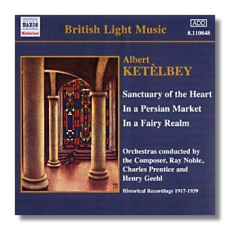
The Internet's Premier Classical Music Source
Related Links
- Latest Reviews
- More Reviews
-
By Composer
-
Collections
DVD & Blu-ray
Books
Concert Reviews
Articles/Interviews
Software
Audio
Search Amazon
Recommended Links
Site News
 CD Review
CD Review
British Light Music

Eric Coates
- Calling All Workers
- Springtime
- From Meadow to Mayfair
- With a Song in My Heart
- London Again
- By the Tamarisk
- The Three Bears
Various orchestras/Eric Coates
Naxos Historical 8.110182 ADD monaural 62:20


Albert Ketèlbey
- The Sacred Hour
- Bells Across the Meadows
- In a Fairy Realm
- Algerian Scene
- Fairy Butterfly
- King Cupid
- In the Mystic Land of Egypt
- Wedgwood Blue
- Sanctuary of the Heart
- In a Persian Market
- A Dream of Christmas
- In a Monastery Garden
Various orchestras and soloists/Albert Ketèlbey, Ray Noble, Charles Prentice, Henry Geehl
Naxos Historical 8.110848 ADD monaural 61:42
These two discs quickly follow initial Coates (8.110173) and Ketèlbey (8.110174) offerings from Naxos Historical. Both of these British composers wrote semi-classical "pops" of the highest quality – in the United States, their counterpart was Leroy Anderson (although Anderson, the product of a later generation, incorporated more pop and jazz elements in his works). Coates, who was born in 1886, studied viola and composition at the London Royal Academy and earned his keep playing the viola in theater orchestras. His early compositions met with no special acclaim. It was only when an attack of neuritis compelled him to stop playing the viola professionally that he applied himself to writing, and then success came and stayed with him, right up to his death in 1957.
Ketèlbey, born in 1875, studied music at Trinity College, and after a period in which he balanced interests in serious classical music and the musical theater, he finally devoted himself to popular (that is to say, semi-classical) compositions for the salon and concert hall. He was named "Britain's Most Popular Composer" in the 1920s. By the time of his death in 1959, his music, like Coates's, was regarded as old-fashioned. Still, it never has fallen out of pantheon of British culture, even if it is now regarded as of greater interest to nostalgia fans, or even as "camp." (If so, it is good camp.)
The first Coates volume included most of the composer's most popular numbers, but there's still plenty to enjoy on this second volume. It is worth noting that With a Song in My Heart is not by Coates but by Rodgers and Hart; this is Coates's "symphonic rhapsody" on Rodgers's tune. Calling All Workers is not a Socialist anthem; Coates wrote it to recognize the contributions of the British people during the Blitz. The second Ketèlbey volume does include major "hits" omitted from the first, notably In a Persian Market and its sound-alike, In the Mystic Land of Egypt. It also includes alternative recordings - later ones - of Sanctuary of the Heart (contralto Nellie Walker sonorously replacing the equally sonorous "unknown") and of In a Monastery Garden (bass Oscar Natzke replacing the irreplaceable Peter Dawson). In the "there always be an England" department, we have soprano Florence Smithson trilling and hooting ridiculous, florid nonsense about a Fairy Butterfly and King Cupid. One keeps waiting for the Marx Brothers to appear and give these sides the good-natured lampooning that they so insistently invite!
As with the earlier volumes, these recordings have been selected and prepared for CD by producer Peter Dempsey. The original materials on the Coates CD are Columbia, HMV, and Decca shellacs recorded between 1930 and 1939. The Ketèlbey discs (Columbia, HMV, and Parlophone) come from as early as 1917 and as late as 1939. As I said in the previous review, many of the sides still produce a surprisingly rich and detailed sound, and surface noise is not a problem. The sound on the two acoustic sides from 1917 (Smithson's two numbers) takes some getting used to, however.
Copyright © 2002, Raymond Tuttle


















